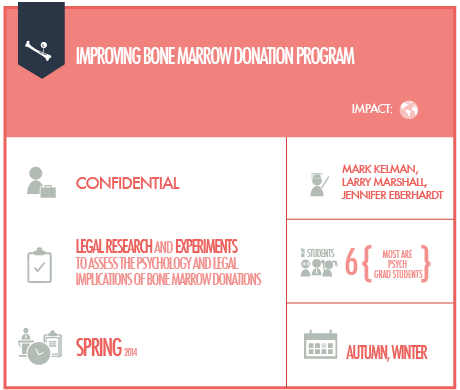Improving Bone Marrow Donation Program

Overview
Individuals who register with a blood donor organization may be identified as potential donors of hematapoietic cells (most typically bone marrow) to patients facing life-threatening disorders such as leukemia, lymphoma, and aplastic anemia whose family members cannot serve as donors. (Family members are appropriate for only 30% of patients needing these transplants.) As donor organizations consider improvements to the procedures that they use to attract people to register, particularly registrants from under-represented ethnic groups who are especially likely to match with co-ethnics. More generally, though, these donor organizations seek to investigate the possibility of increasing the proportion of registrants who, once they are discovered to be a match, actually donate cells once they are discovered to be a match for a particular patient. Stanford social psychologists, working through the recently formed SPARQ (Social Psychologists Answering Real-world Questions) take advantage of the many social psychological insights often employed by those interested in marketing products or increasing charitable donations.
There are questions, of course, about the efficacy of the techniques that social psychologists might recommend in terms of increasing ultimate donation levels. Thus psychology graduate students in the policy practicum helped social psychologists design experimental pilot projects interventions whose impact on long-term donation rates will be evaluated over the next few years. Law students in the policy lab focused particularly on whether proposed techniques run afoul of existing legal regulation or pose other sorts of ethical problems. We paid particular heed to the following sorts of questions: To what extent are proposed interventions consonant with existing medical privacy law? To what extent might they be problematic if they encouraged donations to some classes of patients (e.g. younger or female or co-ethnics) but not to others? What sorts of information must be presented to would-be donors to comply with norms requiring that they give informed consent and how do we insure that their consent is freely given, rather than unduly coerced? What sorts of material incentives for donation, if any, are permissible under current (or ideal) law? If such donations are legal, what stance should the donor organizations take on the use of material incentives?
Clients & Deliverables
Clients:
Deliverables:
- Legal Memoranda
- White Paper
In teams with social psychologists and the Delete Blood Cancer organization, students analyzed the psychological processes and legal concerns associated with potential changes to donation recruitment techniques.


